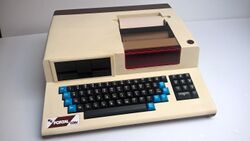Engineering:Portal (computer)
 | |
| Developer | François Gernelle |
|---|---|
| Manufacturer | R2E Micral |
| Type | Portable computer |
| Release date | September 1980 |
| Discontinued | 1983 |
| Units sold | Hundreds |
| Operating system | Prologue, Basic Assembly Language (BAL) |
| CPU | Intel 8085 @ 2 MHz |
| Memory | 64 kB RAM |
| Removable storage | Floppy disk |
| Display | 32-character one-line screen |
| Power | 220-volt |
| Dimensions | 45 × 45 × 15 cm |
| Mass | 12 kg |
Portal R2E CCMC was a portable microcomputer designed and marketed by the Réalisation et Etudes Electroniques department of the French firm R2E Micral,[1] and officially appeared in September 1980 at the Sicob show in Paris.[2][3] Osborne 1, the first commercially successful portable computer, was only released eight months later, on 3 April 1981.[4][5]
The machine was designed with a focus on payroll and accounting. Several hundred Portal computers were sold between 1980 and 1983.
Extremely rare, no museum has a Portal, and only two are in private collections.[6][7]
The company R2E Micral is also known to have designed "the earliest commercial, non-kit computer based on a microprocessor", the Micral N.[8] One of these machines was sold for 62,000 euros to Paul G. Allen, the co-founder of Microsoft (with Bill Gates), by the auctioneer Rouillac on June 11, 2017, for Allen's Seattle museum, Living Computers: Museum + Labs.[9][10][7]
Specifications
The Portal was based on an Intel 8085 processor, 8-bit, clocked at 2 MHz.[1][11]
It was equipped with 64 kB of main RAM, a keyboard with 58 alphanumeric keys and 11 numeric keys (in separate blocks), a LED 32-character one-line screen, a floppy disk (capacity - 140000 characters), a thermal printer (speed - 28 characters/second), an asynchronous channel, a synchronous channel, and a 220-volt power supply.[1][11]
It came with two operating systems: Prologue and Basic Assembly Language (BAL).[1]
Designed for an operating temperature of 15 °C to 35 °C, it weighed 12 kg and its dimensions were 45 × 45 × 15 cm.[1][11]
See also
References
- ↑ 1.0 1.1 1.2 1.3 1.4 "Base de données - R2E Portal". 2018. https://www.system-cfg.com/detail.php?ident=877.
- ↑ "Portal au Sicob". http://blog.museeinformatique.fr/attachment/126350/.
- ↑ Lilen, Henri. la saga du micro-ordinateur.
- ↑ "Pièce comptable Portal". http://blog.museeinformatique.fr/attachment/126351/.
- ↑ Spector, Lincoln (2010-05-31). "A History of Portable Computing". https://www.pcworld.com/article/197457/History_of_Portable_Computing.html.
- ↑ Rouillac, Aymeric (2017-08-21). "Cet exemplaire en état de marche sera vendu aux enchères le 22 septembre 2017". https://www.facebook.com/rouillac/posts/10155683670608824?pnref=story.
- ↑ 7.0 7.1 "Vente aux enchères du Centre de Création Contemporaine Olivier Debré à Tours". 21 August 2017. https://www.rouillac.com/sdoc-677291-c33371575930a08332023a612c8e94c5-artsdesign_rouillac_cccod_22_09_2017.pdf.
- ↑ "R2E Micral N". https://www.system-cfg.com/detail.php?ident=811.
- ↑ "The Micral N, the First Microcomputer, to be Sold at Auction in June" (in en-GB). Life in France. 2017-05-13. http://chb44.com/2017/05/micral-n-first-microcomputer-sold-auction-june/.
- ↑ "C'est maintenant officiel: Paul G.... - Aymeric Rouillac". https://www.facebook.com/rouillac/posts/10155667610863824.
- ↑ 11.0 11.1 11.2 "Plaquette Portal". http://blog.museeinformatique.fr/attachment/126348/.
Bibliography
François Gernelle, Portal designer
Sources
This article is derived partly from the page of old-computers.com and feb-patrimoine.com.
 |

